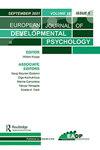母亲对单胎和首胎异卵双胞胎婴儿的言语:一项为期四个月的纵向和自然研究
IF 1.9
4区 心理学
Q3 PSYCHOLOGY, DEVELOPMENTAL
European Journal of Developmental Psychology
Pub Date : 2022-06-21
DOI:10.1080/17405629.2022.2092092
引用次数: 0
摘要
摘要本研究比较了母亲与其首胎异卵双胞胎和单胎婴儿互动时的言语。从第2个月到第6个月,9名双胞胎和9名单胎婴儿在家中与母亲自发的面对面互动进行了录像。连续的微观分析表明,单胎母亲和双胞胎母亲的语言在数量和质量上的相似性大于差异。单胎母亲和双胞胎母亲在主题序列的频率上相似,尽管母亲讲话的持续时间更有利于单胎母亲。单亲妈妈的语言倾向于婴儿的情感和注意力主题序列。然而,单胎母亲和双胞胎母亲对其他婴儿内部状态的反应相似。双胞胎,而不是单胎,母亲的婴儿注意话语在婴儿的注意力有明显进步的时候有所不同。这些结果与先天主体间性理论和双胞胎母亲对婴儿表达的敏感性(与单胎母亲相似)有关。本文章由计算机程序翻译,如有差异,请以英文原文为准。
Maternal speech to singleton and first-born dizygotic twin infants: a four-month longitudinal and naturalistic study
ABSTRACT We compared maternal speech in interactions of mothers with their firstborn dizygotic twin and singleton infants. Nine twins and nine singletons were video-recorded at home in spontaneous face-to-face interactions with their mothers, from the 2nd to the 6th month. Continuous micro-analysis revealed that there are more quantitative and qualitative similarities than differences between singleton and twin mothers’ speech. Singleton and twin mothers are similar in the frequency of thematic sequences though duration of maternal speech favours singletons. Singleton mothers’ speech favours infant emotion and attention thematic sequences. However, singleton and twin mothers responded similarly to the rest infant internal states. Twin, but not singleton, mothers’ infant attention utterances differed at times when there are marked advances in the infants’ attentiveness. These results are discussed in relation to the theory of innate intersubjectivity and the sensitivity that twin mothers, similarly to singleton mothers, express to the young infants’ expressions.
求助全文
通过发布文献求助,成功后即可免费获取论文全文。
去求助
来源期刊

European Journal of Developmental Psychology
PSYCHOLOGY, DEVELOPMENTAL-
CiteScore
3.70
自引率
0.00%
发文量
35
 求助内容:
求助内容: 应助结果提醒方式:
应助结果提醒方式:


